A Rare Coin of Thrasemundus of Maastricht
Arnout Bruins and Dirk Faltin
Recently, an interesting and rare coin of the Dutch city of Maastricht came to light in
England. The coin was found by a metal detectorist on a so-called productive site in
Lincolnshire at England’s east coast. This article presents this coin and places it
into the context of Merovingian coinage from the area of today’s Netherlands.
Maastricht is one of the oldest cities of The Netherlands. The city’s Latin name
Traiectum indicates its important location at a passage (traiectum) over the river Maas.
In the 7th century the city was the seat of the bishops of Tongeren, who only later moved
to Liege. Owing to its prominent location at trade routes connecting Cologne and Boulogne,
the city attained regional importance in the Merovingian period. Maastricht was one of the
three major mints of the eastern Merovingian realm (Austrasia proper), together with
Rheims and Metz.
Maastricht may even have been home to a royal palace, as some of the coins of the monneyer
Godofredus have the city name TRIECTO followed by PA for Palatium. From the early 18th
century, Dutch numismatists and historians were inclined to attribute coins with the place
name TRIECTO to Utrecht. However, since the late 19th century an attribution to Maastricht
is widely accepted.
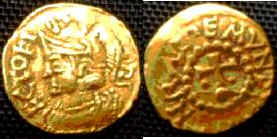
RI IECTOFI THRASEMUNDVS
Tremissis of Thrasemundus of Maastricht,
found recently in England (Lincolnshire)
The Merovingian mint of Maastricht boasted a series of at least ten
monneyers, including Godofredus, Ansoaldus, the well known Madelinus and Thrasemundus, who
was responsible for the coin at hand. Thrasemundus worked in the early decades of the 7th
century and the newly found tremissis can be dated to about 670. The obverse legend reads
(T)RI – ECTOFI(T), i.e. TRIECTO FIT, for Traiectum fitur, meaning ‘produced at
Maastricht’. The reverse spells out the name of the monneyer THRASEMVNDVS. The
reverse design shows a cross on a globe with two pellets on either side, within a circle
of pellets. The obverse of the coin shows a helmeted bust.
In break with the long-accepted design that derived from 5th and 6th century Byzantine
tremisses, Thrasemundus copied the helmeted bust directly from early 4th century Roman
bronze coins. Grierson and Blackburn (Medieval European Coinage, Vol. 1, The Early Middle
Ages p. 118) suggest that the design of the coin under discussion was borrowed from small
bronze coins of Crispus (317-326) or one of his contemporaries. Also, the bust of the
so-called Urbs Roma series may have served as model for our coin. Such recourse to ancient
models is peculiar and very rare, but not unique. Hence, Grierson and Blackburn (op. cit.
p. 118) mention a unique Merovingian tremisses that was based on a coin of Magnentius
(350-353). Interestingly, early Anglo-Saxon tremissis (e.g. the Thrymsas of the
Sutherland, class II type) and solidi were also occasionally based on 4th century designs.
Crispus as well as Constantine struck the helmeted bust type. To decide whether the
Thrasemundus tremissis was based on an Urbs Roma coin, or whether it was based on one of
the other 'helmeted-bust-type folles' as suggested by Grierson and Blackburn is not clear.
There are two arguments for Crispus. Firstly Crispus struck the helmeted bust type in
Trier and London so this type would have been available in larger numbers in Maastricht.
Secondly, we think the Thrasemundus tremissis is stylistically closer to the Crispus
folles than to the Urbs Roma type, but this is a subjective impression.
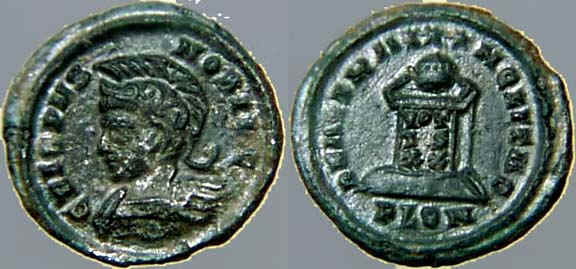
Crispus AE3. CRISPVS NOBIL C, helmeted & cuirassed bust left/
BEATA TRANQLITAS, iglobe on altar inscribed VOT/IS/ XX, PLON in ex.
Why monneyers of the 6th/7th century would occasionally depart from the
established designs remains an open question. Possibly, Thrasemundus may have wished to
distinguish this series from other coins in circulation. Alternatively, the design may not
have been of any consequence and the monneyer might just have chosen any model that was
available and/or appealing to him. The latter argument is supported by the fact that such
breaks with the gradually evolved designs seem to be confined to areas were minting had
been interrupted since Roman times.
Monneyers like Thrasemundus of Maastricht were likely wealthy people, who could support
themselves from other sources at times when no minting was required. It has also been
suggested that the title and office of monneyer was often hereditary in Merovingian times,
as it has been in the Roman Empire before. Merovingian coinage of the 7th century was
highly decentralised and monneyers worked for church authorities, the king or for local
municipalities, as in the case of Thrasemundus.
The coins of Thrasemundus of Maastricht belong to the so-called National Merovingian Gold
Series, which lasted from about 570/80 to 670. Prior to this National Gold Series
Merovingian coins are classified as Pseudo Imperial (500-570/80). These pseudo imperial
coins were more or less faithful copies of Roman and Byzantine coins. During this first
phase of Merovingian coinage, the weight of the tremisses was generally close to the
Byzantine model at about 1.5gr. During the period of the National Gold Series, the weight
dropped to around 1.3gr. The coins of the national series often show the names of
monneyers and mints. At the end of 7th century, minting in gold was gradually phased out
and the tremisses was replaced by silver denarii (pennies or sceatta).
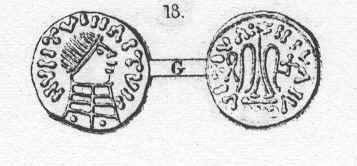
Pseudo Imperial Tremissis of the first phase of Merovingian coinage.
(Stylised bust of the emperor// Victory with cross and wreath, heavily blundered legend)
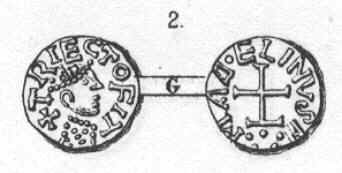
National Gold Tremissis of the second period of Merovingian coinage
(Stylised bust, legend TRIECTO FIT// Cross, legend MADELINUS)
The Thrasemundus tremissis presented here is very rare. According to
information supplied by the Dutch National Collection, only about four exemplars of this
type are known. The tremissis has been registered in the Early Medieval Corpus at
Fitzwilliam Museum, Cambridge. The coin remains in the collection of Dirk Faltin.
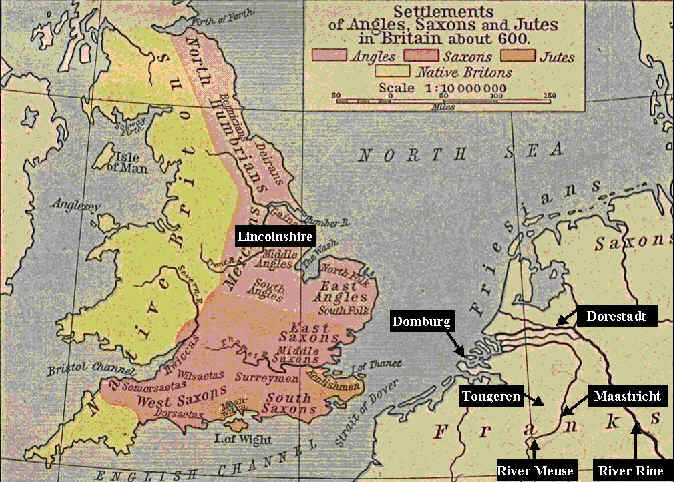
Map with the places important in Merovingian times
Literature: P.O. van de Chijs, ‘munten der Frankische en Duitsch
Nederlandse vorsten’, 1866 |




